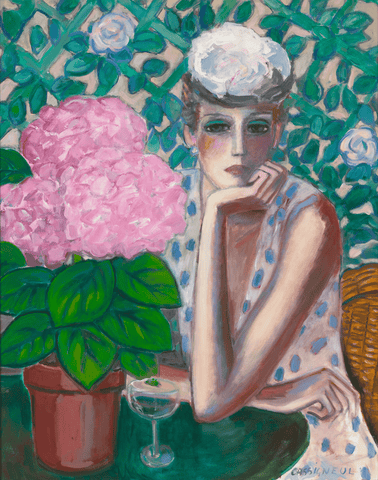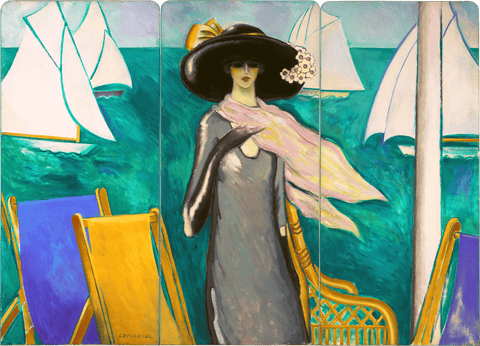Artists & Artisans
Cassigneul, Jean Pierre
One of the most popular living French artists, Jean Pierre Cassigneul is set apart by his unique ability to produce works that feel both dramatically contemporary and timeless in style. Throughout his over 60-year career, Cassigneul’s ability to compose a painting that balances the classical conceptions of beauty with a distinctly modern, urbane sophistication has attracted the eye of the discerning art market and devoted connoisseurs. Cassigneul’s celebrated oeuvre features his beloved sea, Deauville, the banks of Lake Geneva, gardens, and most recognizably, women. With a gentle and consistent intimacy that has withstood the test of time, Cassingneul’s women are beautiful, intriguing and here to stay.
Early Life
Like many of his contemporaries, Cassigneul’s childhood in the 1940s was marked by forced displacement throughout WWII when he was sent from France, his home, to Switzerland for protection. Cassigneul later returned to Paris where his grandfather’s business, the ground-breaking French fashion house Jean Dessès, was bolstered by the burgeoning industry and creativity in a post-war world and soared to new heights. Cassigneul’s adolescent memories include walking through the shop, observing models, dressmakers and runway shows. It is little wonder that the boy would grow into an artist so devoted to the elegance and refinement of the fashionable Parisian woman.
Early Career
Cassigneul produced his first landscapes of Deauville, a seaside resort town near Normandy, in 1947 at just 12 years old. Bolstered by his mother’s love for the arts, he continued painting and five years later he held his first one-man exhibition at seventeen. His first artistic mentor, Jean Souverbie, stage designer and the head of the École des Beaux-Arts in Paris, first introduced Cassigneul to Picasso and Les Nabis, the latter of whom would have a significant effect on the development of his style.
Between 1956 and 1960, Jean-Pierre Cassigneul apprenticed at the studio of Roger Chapelain-Midy, a well-known painter and theatre designer at the École des Beaux-Arts. At a time when the world of modern art was experiencing major upheavals, Cassigneul appreciated Midy’s defense of classical tradition and forms. Additionally, Midy both understood and appreciated Cassigneul’s conception of reality — the artist’s reality, created by the artist themselves, is the one true reality
in a work of art.
During this period, he held numerous exhibitions throughout Paris and was appointed as a member of the Salon d’Automne in 1959. In 1963, he exhibited his works at the Salon de la Jeune Peinture, where his figural portraits stood out amongst the abstract work of his contemporaries, and earned both critical and popular acclaim.
Style
Cassigneul’s style follows the tradition of the French Post-Impressionist group known as Les Nabis, which included celebrated French artists such as Pierre Bonnard, Édouard Vuillard and Maurice Denis. Expressionist painter Kees van Dongen was another important influence on the young Cassigneul, whose portraits resemble van Dongen’s elongated, sharply contoured female forms.
Most of Cassigneul’s female figures feature a simplistic color palate, with bold patterns and pigmentation. In contrast to some of his contemporaries, Cassigneul never paints en plein air. In fact, he never even carries a sketchbook. Instead, Cassigneul is dependent on memory to recreate images from the past, thus creating his own reality.
Subjects
Cassigneul's oeuvre is undeniably dominated by women, a subject often coupled with the sea and gardens. His sleepy-eyed beauties are both enigmatic and glamorous, never smiling, but full of air and lightness while exuding a distinctly French spirit. Vibrant colors and striking brushwork lend his work its contemporary feel, while his feminine subjects are reminiscent of classical art history.
Like the female figure, the sea provides Cassigneul with equal creative inspiration. In an interview, he states, “The sea is an invitation to dream. I can play with light, the seasons, and the wind. A calm sea, the beginnings of a storm... It is a subject I can deal with in an infinite number of ways depending on how I feel.” Even in his seascapes, the artist always instilled a feminine element into each composition.
Cassigneul often depicts his own emotional state through his palette and hues. When he is feeling bright and joyful, the colors he employs often mirror emotional elation. When he is grieving or distressed, he often turns to darker colors and intimate night scenes. Deeply personal while simultaneously modern and timeless, his portraits transcend both time and popular trends; the artist is unwavering in his dedication to elegance.
Legacy
By 1968, Cassigneul's works were being exhibited on both sides of the Atlantic — and beyond. They gained particular favor in Japan where he enjoys an especially devoted following. By the late 1960s, a museum was dedicated in his name, cafés were named in his likeness and stamps were created with his artwork.
Ranked among the best-selling living French artists today, Cassigneul’s prolific success and influence only continue to grow. The entirely “unclassifiable” artist embodies many dichotomies that only enrich his fascinating career. As an artist who despises solitude, craves conversation and social interaction, finds little need to travel and consistently renders simplified figurative paintings instead of abstract expressionism, Cassigneul proves that classical beauty will never fall out of fashion.
Artists & Artisans
Cassigneul, Jean Pierre
One of the most popular living French artists, Jean Pierre Cassigneul is set apart by his unique ability to produce works that feel both dramatically contemporary and timeless in style. Throughout his over 60-year career, Cassigneul’s ability to compose a painting that balances the classical conceptions of beauty with a distinctly modern, urbane sophistication has attracted the eye of the discerning art market and devoted connoisseurs. Cassigneul’s celebrated oeuvre features his beloved sea, Deauville, the banks of Lake Geneva, gardens, and most recognizably, women. With a gentle and consistent intimacy that has withstood the test of time, Cassingneul’s women are beautiful, intriguing and here to stay.
Early Life
Like many of his contemporaries, Cassigneul’s childhood in the 1940s was marked by forced displacement throughout WWII when he was sent from France, his home, to Switzerland for protection. Cassigneul later returned to Paris where his grandfather’s business, the ground-breaking French fashion house Jean Dessès, was bolstered by the burgeoning industry and creativity in a post-war world and soared to new heights. Cassigneul’s adolescent memories include walking through the shop, observing models, dressmakers and runway shows. It is little wonder that the boy would grow into an artist so devoted to the elegance and refinement of the fashionable Parisian woman.
Early Career
Cassigneul produced his first landscapes of Deauville, a seaside resort town near Normandy, in 1947 at just 12 years old. Bolstered by his mother’s love for the arts, he continued painting and five years later he held his first one-man exhibition at seventeen. His first artistic mentor, Jean Souverbie, stage designer and the head of the École des Beaux-Arts in Paris, first introduced Cassigneul to Picasso and Les Nabis, the latter of whom would have a significant effect on the development of his style.
Between 1956 and 1960, Jean-Pierre Cassigneul apprenticed at the studio of Roger Chapelain-Midy, a well-known painter and theatre designer at the École des Beaux-Arts. At a time when the world of modern art was experiencing major upheavals, Cassigneul appreciated Midy’s defense of classical tradition and forms. Additionally, Midy both understood and appreciated Cassigneul’s conception of reality — the artist’s reality, created by the artist themselves, is the one true reality
in a work of art.
During this period, he held numerous exhibitions throughout Paris and was appointed as a member of the Salon d’Automne in 1959. In 1963, he exhibited his works at the Salon de la Jeune Peinture, where his figural portraits stood out amongst the abstract work of his contemporaries, and earned both critical and popular acclaim.
Style
Cassigneul’s style follows the tradition of the French Post-Impressionist group known as Les Nabis, which included celebrated French artists such as Pierre Bonnard, Édouard Vuillard and Maurice Denis. Expressionist painter Kees van Dongen was another important influence on the young Cassigneul, whose portraits resemble van Dongen’s elongated, sharply contoured female forms.
Most of Cassigneul’s female figures feature a simplistic color palate, with bold patterns and pigmentation. In contrast to some of his contemporaries, Cassigneul never paints en plein air. In fact, he never even carries a sketchbook. Instead, Cassigneul is dependent on memory to recreate images from the past, thus creating his own reality.
Subjects
Cassigneul's oeuvre is undeniably dominated by women, a subject often coupled with the sea and gardens. His sleepy-eyed beauties are both enigmatic and glamorous, never smiling, but full of air and lightness while exuding a distinctly French spirit. Vibrant colors and striking brushwork lend his work its contemporary feel, while his feminine subjects are reminiscent of classical art history.
Like the female figure, the sea provides Cassigneul with equal creative inspiration. In an interview, he states, “The sea is an invitation to dream. I can play with light, the seasons, and the wind. A calm sea, the beginnings of a storm... It is a subject I can deal with in an infinite number of ways depending on how I feel.” Even in his seascapes, the artist always instilled a feminine element into each composition.
Cassigneul often depicts his own emotional state through his palette and hues. When he is feeling bright and joyful, the colors he employs often mirror emotional elation. When he is grieving or distressed, he often turns to darker colors and intimate night scenes. Deeply personal while simultaneously modern and timeless, his portraits transcend both time and popular trends; the artist is unwavering in his dedication to elegance.
Legacy
By 1968, Cassigneul's works were being exhibited on both sides of the Atlantic — and beyond. They gained particular favor in Japan where he enjoys an especially devoted following. By the late 1960s, a museum was dedicated in his name, cafés were named in his likeness and stamps were created with his artwork.
Ranked among the best-selling living French artists today, Cassigneul’s prolific success and influence only continue to grow. The entirely “unclassifiable” artist embodies many dichotomies that only enrich his fascinating career. As an artist who despises solitude, craves conversation and social interaction, finds little need to travel and consistently renders simplified figurative paintings instead of abstract expressionism, Cassigneul proves that classical beauty will never fall out of fashion.





